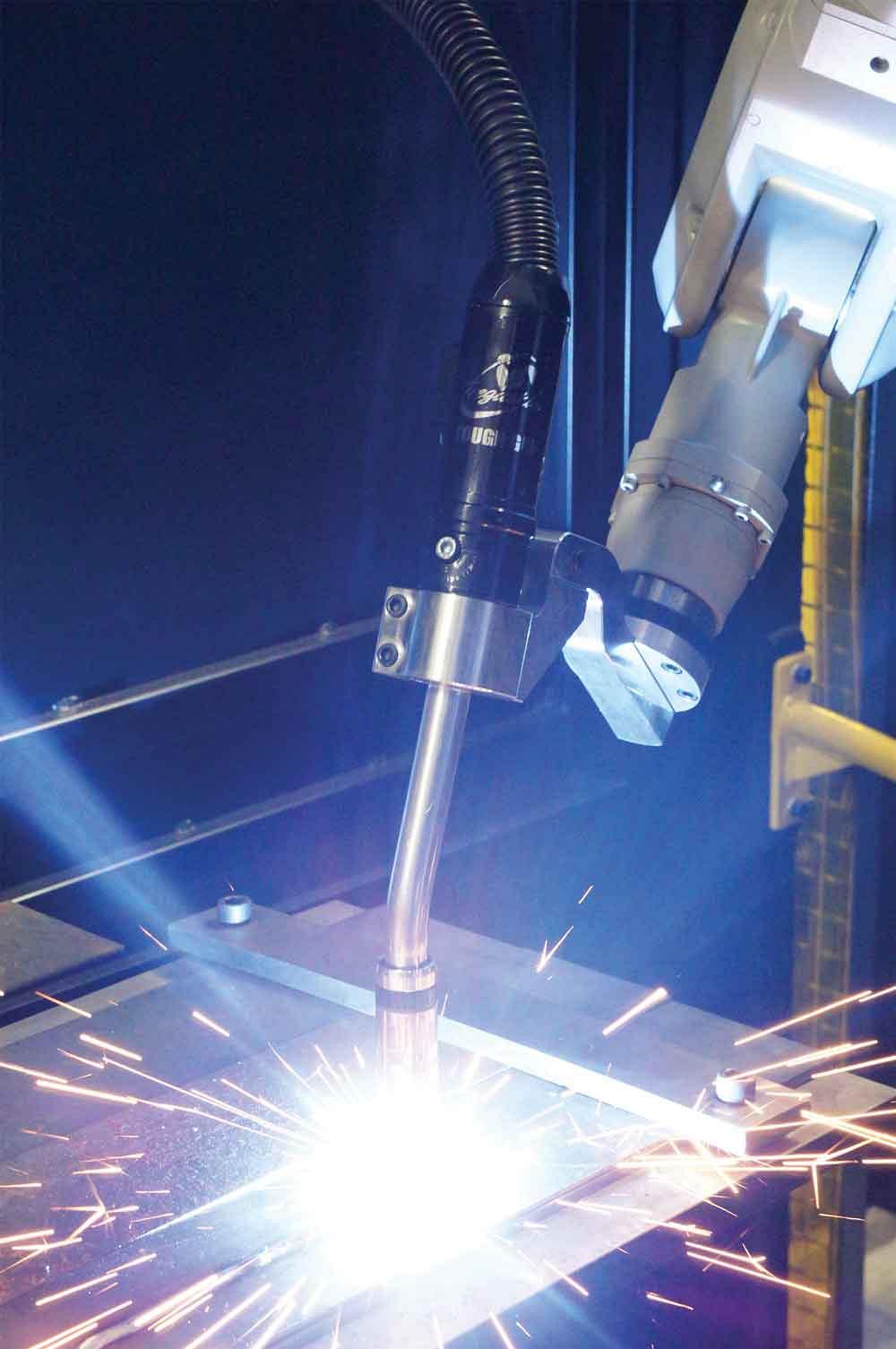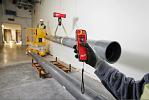- FMA
- The Fabricator
- FABTECH
- Canadian Metalworking
Welding Tech: Keeping your welding robots fit
Preventing five causes of downtime in a robotic welding operation
- By Jeff Wells
- October 1, 2016

Having welding operators and robotic weld cell supervisors who can quickly troubleshoot and solve problems makes all the difference when it comes to keeping costs down, generating high-quality results, and maintaining optimal efficiency.
Whether or not a robotic welding cell stays productive and consistently generates a positive return on investment is determined, in large part, by the amount of downtime it incurs. Since robotic welding systems are built for speed, accuracy, and repeatability, the cost of arc-off time spent addressing issues is exponentially higher than in a typical welding cell. Having welding operators and robotic weld cell supervisors who can quickly troubleshoot and solve problems makes all the difference when it comes to keeping costs down, generating high-quality results, and maintaining optimal efficiency.
Here are five common causes of downtime that can occur in a robotic welding operation, along with ways to prevent and address them.
No. 1: Poor Cable Management and/or Incorrect Cable Selection
If a power cable rubs against the robot, on parts or against tooling on the robot, it can prematurely fail and cause unnecessary downtime. In some cases, the cable may even catch on components and wear them out, too.
Cables that are too long or too short create excessive strain by either being pulled too tight or flopping around too much at the front housing — both of which lead to premature cable failure. These issues are common with conventional-style robots, where the power cable connecting to the robotic gas metal arc welding (GMAW) gun is external to the robot arm. The goal is to set the cable length so that it exits the front housing with a smooth arc, resulting in minimal strain.
Alternately, in the case of a through-arm robotic welding system, downtime often occurs due to improper installation of the gun and/or improper cable length.
Solutions: By adding cable tensioners, which are essentially spring-loaded cable devices that hold the power cable, you can ensure the cables stay properly supported on a conventional robot. Programming the robot so that it doesn’t accelerate or decelerate too quickly or abruptly can also protect against premature cable failure.
In some cases, if the work envelope is quite small, cable rubbing may be unavoidable. Using a protective wrap to shield the cable from rubbing can help. These are available in the marketplace as either a leather or woven nylon cover or as a plastic spiral wrap.
When installing a through-arm robotic GMAW gun, be sure to position the robot with the wrist and top axis at 180 degrees, parallel to each other. Then install the insulating disc and spacer the same as on a conventional over-the-arm robotic GMAW gun. Always be sure the power cable position is correct and has the proper “lie” with the robot’s top axis at 180 degrees, and ensure the power cable has about 1.5 inches of slack when installing it, so it is not too taut.

Excessive spatter buildup in consumables, as shown here, can be caused by a nozzle cleaning station that isn’t operating properly and can easily cause unnecessary downtime
No. 2: Premature Consumable Failure
Although consumables may seem like a small part of the robotic welding process, they can have a big impact on how productive and effective an operation is. Nozzles, contact tips, retaining heads (or diffusers), and liners can all fail prematurely or perform poorly for a variety of reasons, including spatter or debris buildup, loose connections, and improper installation. Issues with the contact tip — especially burnbacks — also relatively common, are often caused by a liner being trimmed too short.
Solutions: Always inspect consumables for signs of spatter or debris buildup during routine breaks in production and, if signs of either are present, replace or clean them. Check that the nozzle cleaning station or reamer is working properly and that it is programmed to ream at a rate that is appropriate for that specific application. It may be necessary to increase the frequency of the antispatter spray application or reaming throughout the programmed welding cycle.
It is also important to check that all consumable connections are clean and secure, as loose connections can generate additional heat through increased electrical resistance, shortening consumable life or causing them to perform poorly.
Always follow the manufacturer’s instructions for liner trimming and installation, as a liner can cause inconsistent feeding if it is cut too short. It is a good idea to use a liner gauge to confirm the correct liner length.
Spring-loaded modules work in conjunction with a front-loading liner to help minimize issues if the liner is cut to an incorrect length. These are housed in the power pin and apply forward pressure on the liner after it is installed. They typically allow up to 1 inch of forgiveness if the liner is too short.
It is also important to replace liners frequently enough, as a clogged liner full of debris and dirt will not feed properly and may cause premature contact tip failure.
No. 3: Excessive Spatter Buildup in Consumables
Excessive spatter buildup in consumables can be caused by a nozzle cleaning station that isn’t operating properly and can easily cause unnecessary downtime. Issues related to nozzle cleaning stations can be caused by an incorrect position between this peripheral and the robotic GMAW gun nozzle; poor antispatter compound coverage; or a dull or improperly sized cutter blade.

If a nozzle cleaning station doesn’t appear to be working properly, first check that the robotic GMAW gun is concentric to the cutting blade on the reamer. Misalignment of the nozzle can lead to partial cleaning and excessive spatter buildup.
Solution: If a nozzle cleaning station doesn’t appear to be working properly, first check that the robotic GMAW gun is concentric to the cutting blade on the reamer. Misalignment of the nozzle can lead to partial cleaning and excessive spatter buildup.
Also check that the antispatter sprayer is full, correctly positioned, and properly coating the nozzle during spraying. The nozzle should be slightly damp on the inside and outside and covered up to 3/4 inch from the bottom of the nozzle. Note that overspraying antispatter compound can cause nozzles to deteriorate prematurely, so it should never be sprayed for more than half a second.
The cutter blade must match the diameter of the nozzle bore, so that it can effectively clean during the ream cycle without hitting the nozzle or the gas diffuser. It is also important to have a sharp cutter blade and to make sure that the nozzle is at the correct depth within the jaws of the nozzle cleaning station.
Finally, adding an air blast feature to a robotic GMAW gun can help support the nozzle cleaning station’s overall effectiveness. An air blast feature blows high-pressure air through the gun’s front end, which helps remove spatter, debris, and other contaminants. This feature can help reduce how often a nozzle cleaning station needs to be used and, ultimately, boost productivity.
No. 4: Collisions
Collisions can occur as the result of tooling that hasn’t been secured properly, an item inadvertently being left in the weld cell, or poor part fit-up. Unfortunately, not only can collisions create unwanted downtime, but they can also damage the robot arm, the robotic GMAW gun, and front-end consumables.
Solutions: For robots that don’t have built-in collision software, a shock sensor can act as a safety device to protect the robot arm and gun from damage if the robot crashes. In the event of a collision, the shock sensor sends a signal back to the robot to alert it to shut down.
Many newer robots are equipped with collision detection software that serves the same function as a shock sensor, but some companies still use a shock sensor as a backup safety measure.
In order to determine that the shock sensor switch is working properly, conduct a continuity check in the open and closed position of the switch using a multimeter or manually trip it by bumping the neck with their hand. If the sensor is working properly, it will send a signal back to the robot indicating there is a problem.
Always reset the shock sensor to its home position and recheck the tool center point (TCP) after a collision, and then confirm that both the TCP and clutch are correct.
If you are using a newer robot with collision detection software, make sure it's set up correctly and that both the TCP and center of mass or balancing point have been programmed according to the gun manufacturer’s specifications. Doing so helps ensure the robot will react properly in the event of a collision.
No. 5: Poor Wire Feeding
Poor wire feeding in a robotic welding system is usually caused by one of three things: (1) issues with the liner, such as a clogged liner; (2) a wire feeder that isn’t functioning properly; or (3) power cable kinking. Regardless of the cause, the result is poor arc stability and weld quality.
Solution: As previously mentioned, regularly changing the liner and using a robotic GMAW gun with an air blast feature help eliminate debris in a liner. If an air blast feature is not available, you can also manually blow compressed air through the liner periodically.
If you suspect that the wire feeder’s drive rolls are the culprits of the poor wire feeding, there are two ways to further investigate and assess the situation. One is to visually inspect the drive rolls for signs of wear, and the other is to conduct a “two-finger” test. The latter involves disengaging the drive rolls, grasping the welding wire, and pulling it through the gun. You should be able to pull the wire easily with two fingers.
Last, look for kinks in the power cable, which can also lead to poor wire feeding, and then straighten or unwind the cable, if necessary.
Remember, knowing how to troubleshoot common problems in a robotic welding operation can make the difference between costly downtime and consistently productive, arc-on time. And making the effort to address potential issues upfront can actually save time and money in the long run.
Jeff Wells is engineering manager, Tregaskiss, 855-644-9353, www.tregaskiss.com.
subscribe now


Keep up to date with the latest news, events, and technology for all things metal from our pair of monthly magazines written specifically for Canadian manufacturers!
Start Your Free SubscriptionAbout the Author
- Industry Events
ZEISS Quality Innovation Days 2024
- April 15 - 19, 2024
Tube 2024
- April 15 - 19, 2024
- Düsseldorf, Germany
CTMA Economic Uncertainty: Helping You Navigate Windsor Seminar
- April 30, 2024
- Windsor, ON Canada
MME Winnipeg
- April 30, 2024
- Winnipeg, ON Canada
CTMA Economic Uncertainty: Helping You Navigate Kitchener Seminar
- May 2, 2024
- Kitchener, ON Canada




















